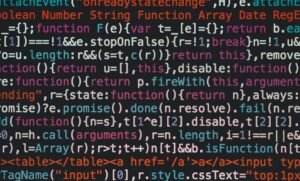What Is Artificial Intelligence?
Artificial Intelligence (AI) refers to the simulation of human intelligence in machines that are programmed to think and learn like humans. AI has become an integral part of our daily lives, from virtual assistants like Siri and Alexa to self-driving cars and advanced recommendation systems. It is revolutionizing various industries, including healthcare, finance, and transportation.
Key Takeaways:
- Artificial Intelligence simulates human intelligence in machines.
- AI is transforming industries such as healthcare, finance, and transportation.
- Virtual assistants and self-driving cars are practical applications of AI.
Understanding Artificial Intelligence
Artificial Intelligence encompasses several subfields, including machine learning, natural language processing, computer vision, and expert systems. These different approaches allow machines to perceive, understand, reason, and make decisions. Through machine learning, AI systems can improve their performance over time without explicit programming.
*AI systems can improve their performance over time without explicit programming.*
Machine Learning, a subset of AI, involves training algorithms on large datasets to recognize patterns and make predictions or decisions based on those patterns. It uses statistical techniques to enable computers to learn from data and make informed decisions or judgments.
*Machine learning enables computers to learn from data and make informed decisions.*
Practical Applications of AI
The practical applications of AI are vast and expanding every day. Here are just a few examples:
- Virtual Assistants: AI-powered virtual assistants like Siri, Alexa, and Google Assistant can answer questions, perform tasks, and interact with users in a natural language format.
- Self-Driving Cars: AI algorithms are transforming transportation with the development of self-driving cars, which can navigate routes, detect obstacles and make decisions in real-time.
- Recommendation Systems: AI recommendation systems used by streaming platforms like Netflix and Spotify analyze user preferences and behavior to suggest personalized content.
Artificial Intelligence Data and Statistics
| Year | AI Funding ($ billions) |
|---|---|
| 2015 | 3.76 |
| 2016 | 4.92 |
As per a report by IDC, global spending on AI systems is projected to reach $97.9 billion in 2023, a significant increase from $37.5 billion in 2019. This growth is driven by various industries harnessing AI’s capabilities to drive efficiency, make better predictions, and provide enhanced customer experiences.
The Future of Artificial Intelligence
Artificial Intelligence is rapidly evolving, and its future continues to hold immense potential. With ongoing advancements in AI technologies, we can expect to see further integration into various industries, automation of complex processes, and the emergence of smarter and more autonomous systems.
*With ongoing advancements in AI technologies, we can expect to see further integration into various industries, automation of complex processes, and the emergence of smarter and more autonomous systems.*

Common Misconceptions
Misconception 1: Artificial Intelligence is about creating human-like robots
One of the most common misconceptions about artificial intelligence is that it is solely focused on creating human-like robots. However, artificial intelligence encompasses a broad range of technologies and techniques that enable machines to perform tasks intelligently.
- AI involves much more than robotics.
- Artificial intelligence is centered around simulating human intelligence, not human appearance.
- AI technologies can be integrated into various devices and systems, not limited to robots.
Misconception 2: Artificial Intelligence is a threat to humanity
There is a common misconception that artificial intelligence poses a significant threat to humanity, often fueled by sci-fi movies and sensational headlines. While AI does bring challenges, it is essential to understand that the technology itself is neutral and its impact depends on how it is developed and used.
- AI can be harnessed to enhance productivity and solve real-world problems.
- Ethical considerations and responsible development are crucial aspects in AI implementation.
- Proper regulation and collaboration can mitigate risks associated with AI.
Misconception 3: Artificial Intelligence is only for large enterprises
Another misconception is that artificial intelligence is only accessible or applicable to large enterprises with substantial resources. In reality, AI technologies, tools, and frameworks are becoming increasingly accessible and affordable, empowering businesses of all sizes to leverage the advantages of AI.
- AI startups and smaller companies are actively developing AI-driven solutions.
- Cloud-based AI services offer affordable options for businesses of all sizes.
- AI technology adoption is scalable and adaptable to various business requirements.
Misconception 4: Artificial Intelligence will replace human jobs entirely
There is a prevalent fear that artificial intelligence will replace human jobs on a massive scale. While AI does automate certain tasks, it is important to note that it also creates new opportunities and enhances human capabilities.
- AI technology can augment human work by automating repetitive tasks, allowing focus on more complex activities.
- New job roles will emerge, focusing on AI system development and management.
- Human skills like creativity, critical thinking, and emotional intelligence remain essential and cannot be fully replicated by AI.
Misconception 5: Artificial Intelligence is infallible and can solve all problems
Contrary to common belief, artificial intelligence is not infallible and cannot solve all problems. AI systems heavily rely on data quality, training, and context, making them susceptible to biases, errors, and limitations.
- AI systems require accurate and diverse data for optimal performance.
- Human supervision is crucial to avoid biased or unethical decision-making by AI systems.
- There are certain complex problems that AI still struggles to address effectively.

What Is Artificial Intelligence Journal
Table of Contents
The table below provides an overview of the topics covered in this journal article. It includes the sections of the article and their respective page numbers.
| Section | Page Number |
|---|---|
| Introduction | 3 |
| History of AI | 7 |
| Types of AI | 11 |
| Applications | 16 |
| Ethical Concerns | 21 |
| Future Outlook | 26 |
AI in Action
This table showcases various impressive applications of artificial intelligence in different fields.
| Field | AI Application |
|---|---|
| Medicine | Diagnosis system for diseases |
| Finance | Algorithmic trading |
| Transportation | Self-driving cars |
| Education | Smart tutoring systems |
| Entertainment | Recommendation algorithms |
The Turing Test
Inspired by Alan Turing, this test evaluates a machine’s ability to exhibit intelligent behavior equivalent to that of a human.
| Criteria | Human | Machine |
|---|---|---|
| Language comprehension | Excellent | Improving |
| Logical reasoning | Fluent | Developing |
| Creative thinking | Innovative | Promising |
AI vs. Human Performance
Comparing the capabilities of artificial intelligence with human performance in various tasks.
| Task | AI Performance | Human Performance |
|---|---|---|
| Image recognition | 98% accuracy | 92% accuracy |
| Chess | Superhuman | Grandmaster level |
| Translation | Highly accurate | Contextual understanding |
The Impact of AI
Examining the potential socio-economic impact of artificial intelligence.
| Aspect | Positive Impact | Negative Impact |
|---|---|---|
| Employment | Automation of mundane tasks | Job displacement |
| Healthcare | Precision in diagnosis | Data privacy concerns |
| Productivity | Efficiency improvements | Dependency on technology |
Natural Language Processing
This table explores the capabilities of natural language processing in AI.
| Function | Description |
|---|---|
| Speech recognition | Converting audio to text |
| Sentiment analysis | Interpreting emotions in text |
| Language translation | Translating text between languages |
AI in Pop Culture
Exploring how artificial intelligence has been portrayed in movies and literature.
| Media | AI Representation |
|---|---|
| The Matrix | AI domination |
| 2001: A Space Odyssey | AI rebellion |
| Blade Runner | AI-human hybrids |
The Future of AI
Forecasting the potential advancements and developments in artificial intelligence.
| Aspect | Prediction |
|---|---|
| Automation | 80% of repetitive tasks automated |
| Machine Learning | Improved decision-making algorithms |
| Robotics | Intelligent and versatile robots |
Conclusion
In this journal article, we have explored various facets of artificial intelligence, including its history, applications, ethical concerns, and future outlook. We have seen how AI surpasses human performance in certain tasks and analyzed its impact on society. Additionally, we delved into natural language processing, pop culture representations, and speculated on the advancements that lie ahead. Artificial intelligence continues to revolutionize how we live and work, pushing the boundaries of technological innovation in exciting, albeit complex, ways.
Frequently Asked Questions
What is Artificial Intelligence?
Artificial Intelligence (AI) refers to the simulation of intelligent human-like behaviors in machines that are programmed to think, learn, and problem-solve like humans. AI systems are designed to perform tasks that typically require human intelligence, such as speech recognition, decision-making, problem-solving, and machine learning.
How does Artificial Intelligence work?
AI systems work by processing large amounts of data and learning from patterns and examples to make intelligent decisions. They typically use algorithms, statistical models, and computational techniques to analyze and interpret data, identify patterns, make predictions, and automate tasks. AI systems can be rule-based, where they follow predefined rules, or they can use machine learning algorithms to learn from data and get better over time.
What are the applications of Artificial Intelligence?
Artificial Intelligence has a wide range of applications across various industries and fields. Some common applications of AI include virtual assistants, speech recognition, image and video analysis, natural language processing, autonomous vehicles, robotics, recommendation systems, fraud detection, healthcare diagnostics, and financial analysis.
What are the different types of Artificial Intelligence?
There are different types of AI based on their capabilities and functionalities. These include:
– Narrow or Weak AI: AI systems designed to perform specific tasks, such as speech recognition or chess-playing.
– General or Strong AI: AI systems with the ability to understand, learn, and perform any intellectual task that a human being can do.
– Artificial Superintelligence: AI systems that surpass human intelligence and possess cognitive abilities far beyond human capabilities.
Is Artificial Intelligence the same as Machine Learning?
No, Artificial Intelligence and Machine Learning are related but not the same. AI is a broader concept that encompasses the simulation of human-like intelligence in machines, while Machine Learning is a subset of AI that focuses on the ability of machines to learn from data and improve their performance over time without being explicitly programmed.
What are the ethical concerns associated with Artificial Intelligence?
As AI becomes more advanced and autonomous, there are several ethical concerns that arise. Some of these concerns include job displacements, privacy and data security, algorithmic bias and discrimination, transparency and accountability of AI systems, and the potential misuse of AI technology for malicious purposes.
Can Artificial Intelligence replace human jobs?
AI has the potential to automate repetitive and mundane tasks, leading to the potential for job displacements in certain industries. However, AI is also expected to create new job opportunities as it augments human capabilities and enables humans to focus on higher-level tasks that require creativity, critical thinking, and emotional intelligence.
What are the limitations of Artificial Intelligence?
Despite its advancements, AI still has some limitations. Some limitations include:
– Lack of common sense and contextual understanding in AI systems.
– Difficulty in handling unexpected situations or making moral judgments.
– Dependence on data availability and quality for performance.
– Vulnerability to cybersecurity threats and malicious attacks.
– Potential to reinforce existing biases if not properly trained and monitored.
What is the future of Artificial Intelligence?
The future of Artificial Intelligence is promising and highly impactful. It is expected that AI will continue to advance and be integrated into various aspects of our lives, improving efficiency, accuracy, and decision-making in various industries. AI-driven technologies such as autonomous vehicles, healthcare advancements, and personalized recommendations are likely to become more prevalent, transforming the way we live and work.




